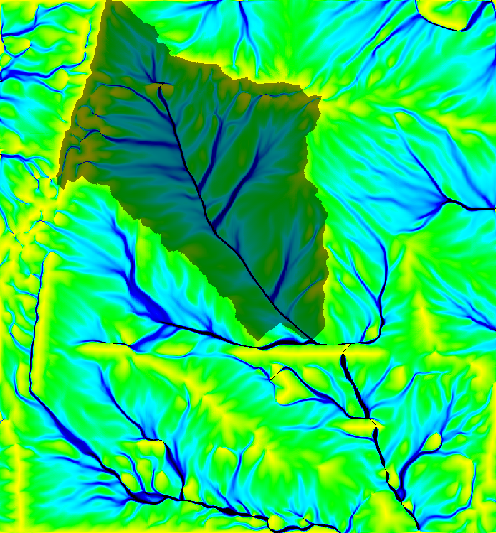r.water.outlet
Creates watershed basins from a drainage direction map.
r.water.outlet input=name output=name coordinates=east,north [--overwrite] [--verbose] [--quiet] [--qq] [--ui]
Example:
r.water.outlet input=name output=name coordinates=0.0
grass.script.run_command("r.water.outlet", input, output, coordinates, overwrite=None, verbose=None, quiet=None, superquiet=None)
Example:
gs.run_command("r.water.outlet", input="name", output="name", coordinates=0.0)
grass.tools.Tools.r_water_outlet(input, output, coordinates, overwrite=None, verbose=None, quiet=None, superquiet=None)
Example:
tools = Tools()
tools.r_water_outlet(input="name", output="name", coordinates=0.0)
This grass.tools API is experimental in version 8.5 and expected to be stable in version 8.6.
Parameters
input=name [required]
Name of input drainage direction map
output=name [required]
Name for output watershed basin map
coordinates=east,north [required]
Coordinates of outlet point
--overwrite
Allow output files to overwrite existing files
--help
Print usage summary
--verbose
Verbose module output
--quiet
Quiet module output
--qq
Very quiet module output
--ui
Force launching GUI dialog
input : str, required
Name of input drainage direction map
Used as: input, raster, name
output : str, required
Name for output watershed basin map
Used as: output, raster, name
coordinates : tuple[float, float] | list[float] | str, required
Coordinates of outlet point
Used as: input, coords, east,north
overwrite : bool, optional
Allow output files to overwrite existing files
Default: None
verbose : bool, optional
Verbose module output
Default: None
quiet : bool, optional
Quiet module output
Default: None
superquiet : bool, optional
Very quiet module output
Default: None
input : str | np.ndarray, required
Name of input drainage direction map
Used as: input, raster, name
output : str | type(np.ndarray) | type(np.array) | type(gs.array.array), required
Name for output watershed basin map
Used as: output, raster, name
coordinates : tuple[float, float] | list[float] | str, required
Coordinates of outlet point
Used as: input, coords, east,north
overwrite : bool, optional
Allow output files to overwrite existing files
Default: None
verbose : bool, optional
Verbose module output
Default: None
quiet : bool, optional
Quiet module output
Default: None
superquiet : bool, optional
Very quiet module output
Default: None
Returns:
result : grass.tools.support.ToolResult | np.ndarray | tuple[np.ndarray] | None
If the tool produces text as standard output, a ToolResult object will be returned. Otherwise, None will be returned. If an array type (e.g., np.ndarray) is used for one of the raster outputs, the result will be an array and will have the shape corresponding to the computational region. If an array type is used for more than one raster output, the result will be a tuple of arrays.
Raises:
grass.tools.ToolError: When the tool ended with an error.
DESCRIPTION
r.water.outlet generates a watershed basin from a drainage direction map and a set of coordinates representing the outlet point of the watershed.
Input drainage direction map indicates the "aspect" for each cell. Multiplying positive values by 45 will give the direction in degrees that the surface runoff will travel from that cell. The value -1 indicates that the cell is a depression area. Other negative values indicate that surface runoff is leaving the boundaries of the current geographic region. The absolute value of these negative cells indicates the direction of flow. This raster map is generated from r.watershed.
Output raster map values of one (1) indicate the watershed basin. Values of zero (0) are not in the watershed basin.
NOTES
In the context of this program, a watershed basin is the region upstream of an outlet point. Thus, if the user chooses an outlet point on a hill slope, the resulting map will be a thin sliver of land representing the overland slope uphill of the point.
EXAMPLE
A watershed in the North Carolina sample dataset region:
g.region raster=elev_lid792_1m -p
# the watershed outlet position should be placed on a stream (from
# accumulation map):
r.watershed elev_lid792_1m threshold=5000 accumulation=accum_5K drainage=draindir_5K basin=basin_5K
r.water.outlet input=draindir_5K output=basin_A30 coordinates=638740.423248,220271.519225
d.mon wx0
d.rast map=accum_5K
d.rast map=basin_A30
# overlay with transparency
r.colors map=basin_A30 color=grey
d.his h=accum_5K i=basin_A30
# report outlet size in ha
r.report map=basin_A30 units=h

Figure: Watershed draped over flow accumulation
SEE ALSO
r.wateroutlet.lessmem (addon), d.where, r.basins.fill, r.watershed, r.topidx
AUTHOR
Charles Ehlschlaeger, U.S. Army Construction Engineering Research Laboratory
SOURCE CODE
Available at: r.water.outlet source code
(history)
Latest change: Tuesday Jul 01 10:05:22 2025 in commit 041dfcd